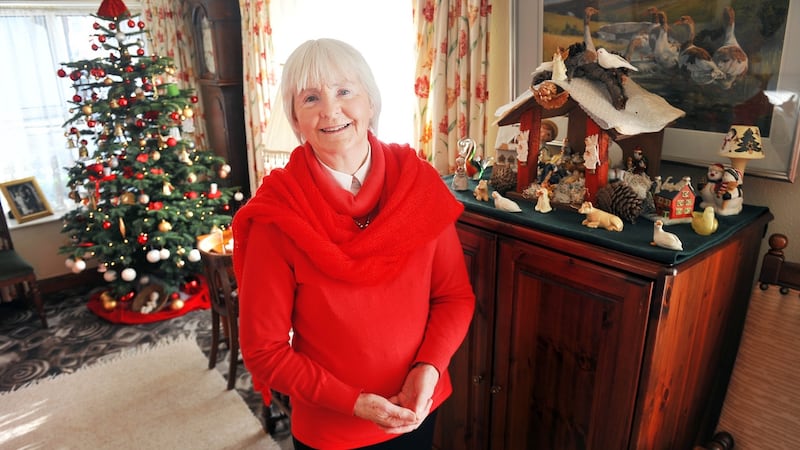Alice Taylor keeps her favourite Christmas presents outside the back door in Innishannon - a trailer-load of west Cork logs, and a small mountain of turf from Kerry.
"There's something lovely about the comfort and the richness of a pile of logs," says Taylor, author of To School Through the Fields, the biggest-selling book ever published in Ireland.
“My niece is married to a farmer outside the village. A few years ago he was extending the milking parlour, and had to cut down some trees, so now every year he brings me a trailer-load of logs...There’s such a great feeling of plenty in having a heap of logs outside the back door.”


The 79-year-old has just published her 24th book, Home for Christmas. Since To School Through The Fields was first published in 1988, Taylor has enjoyed a series of best-sellers, including And Time Stood Still, The Gift of a Garden and Tea and Talk.
“My son Michael gets the turf from Kerry and there’s such a scent from it,” she says from her spot on a sofa close to a blazing turf fire. “I like practical presents; turf and logs and shrubs - maybe it’s to do with the fact that as you age, you grow out of the bling.
“And when the fire’s done, you can use the ashes from the turf and the logs by putting it back into the garden as compost,” she explains. “A surprise is lovely too, though. I think that’s what Christmas is all about - the surprise element,”
Taylor’s fondness for all things Christmassy hits you the moment she opens her front door on the main street of the west Cork village where she’s lived for more than 50 years.
The house is redolent with the sights and scents of the Christmas season, from the frankincense-scented candle in the hallway to the home-made mince pies on the tray in the sitting-room. The mantelpiece above the fire is draped in festive red-and-gold pennants and holds a much-loved family heirloom; the paper crib which Taylor and her sister Phil, bought together as children.
“We thinned turnips and picked spuds to earn the money, and relatives would ‘stand’ you tuppence,” says Taylor, who has five adult children, four sons and a daughter.
The old paper piece is just one of three cribs on display in her home - in the other sitting-room, next door, is a sturdy wooden crib made by her son Michael when he was attending secondary school.
It shelters the porcelain crib figures Taylor bought for her parents in the 1950s after getting her first cheque having started work in the telephone exchange in Killarney.
The set cost the-then princely sum of 17/6, she recalls. Out in the hall, perched on an antique credenza and draped in wonderful gold-printed muslin, is the third, and most unusual crib.
This is essentially a large, beautifully shaped piece of driftwood she found on the beach in Ballybunion. It lives in the garden during the summertime, she explains, but comes into the house at Christmas.
Today, its spurs crowded with birds, flowers and stars, it shelters a real bird’s nest in which nestles the Infant Jesus. Around him stands a circle of traditional crib figures more than half a century old.
Guarding the display stands a statue of St Francis of Assisi, who, explains Taylor, originally came up with the idea of erecting cribs for Christmas.
“I brought that statue back with me from Assisi under my arm in 1996 - I was afraid to put him in the hold of the plane in case he’d come back in pieces.”
Her Christmas tree is up, topped with a red faerie queen . These days Taylor actually gets to select her tree. It wasn’t always that way.
“I get my tree nowadays from John O’Sullivan, a farmer at the edge of the village, and have done for many years.
“Prior to that, our late postman Charlie McNamara used to deliver our Christmas tree by throwing one over the garden wall. God bless him he simply landed it over the wall and it was always grand.”
As for the bunches of holly in jugs everywhere, she picks most of it from the five holly trees growing in her garden.
“One of the first things I do for Christmas is go out into the garden and collect the holly and bring it into the back porch on a fine day.
“I have five or six holly trees and I only take a bit from each. A friend of mine brings me native red-berry holly from the Black Valley in Kerry, and I keep it in jugs of water.”
Taylor says she developed her love of Christmas from her mother Lena.
“My mother was a big Christmas person. She instilled a sense of Christmas into her five daughters; it was very much about the sense of the sacredness of Christmas.
“Christmas brings comfort. There’s something in Christmas, an unexplainable mystery and we cannot crack it.”
“My latest book is dedicated to my mother, who used to say we are not made of stone; we need the spiritual element in our lives.
“Even though we may think we don’t need it, we do. Christmas answers that need in us. My grandmother used to say that the gates of heaven are open at Christmas,” observes Taylor, who adds that she decided to write Home for Christmas as a special thank-you to her mother:
“I want to pass on her idea of Christmas. You must appreciate the sacredness of Christmas because if you vacuum out the sacredness of Christmas you lose Christmas.
“People who are bereaved during the year can often dread Christmas but sometimes the real Christmas can be very healing.
“When I was in that situation I found midnight mass very moving,” recalls Alice, whose husband Gabriel Murphy died in 2005. “At Christmas you’re closer to things you don’t understand.”












